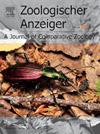应用几何形态计量学研究南美洲Cormocephalus Newport, 1844的形态变异(足足目,Scolopendromorpha, Scolopendromorpha, scolopendendmorpha, scolopendendmorpha, scolopendendmorpha, scolopendendmorpha),以及哥伦比亚一新种的描述
IF 1.5
3区 生物学
Q2 ZOOLOGY
引用次数: 0
摘要
Cormocephalus Newport, 1844属的一些种是基于少数标本描述的,这使得难以量化种内和种间的形态变化。因此,一些诊断形态学特征可能是模棱两可的或在种界中没有真正的分类价值。在这种背景下,几何形态计量学成为一种有价值的工具,能够以定量的方式评估给定分类单元的形状变化,有助于澄清关于其形态特征的假设。本研究采用几何形态计量学方法记录了C. andinus (Kraepelin, 1903)、C. brasiliensis Humbert &;索绪尔,1870年,C. guildingii Newport, 1845年,分布于南美洲。目的是评价和描述属内种间的形态差异。此外,在该属内描述的13种南美洲物种中,有10种被审查并用作描述哥伦比亚新种的比较材料。结果扩大了研究种的地理分布,更新了属guildingii亚群的种表。在分类上提出了以下变化:C.丰antis González-Sponga(2000)和C. edithae González-Sponga(2000)被认为是C. brasiliensis的低级同义种;amazonae (Chamberlin, 1914),作为C. andinus的初级同义词;和C. facilis González-Sponga, 2000, C. glabratus González-Sponga, 2000,和C. maritme González-Sponga, 2000作为C. guildingii的初级同义词。在几何形态方面,三种结构的形状在物种之间存在显著差异:典型变量分析显示低形状重叠。交叉验证试验显示,头钢板的一般识别率为81.25%,圆锥圆锥石的一般识别率为84.00%,红土石21的一般识别率为73.49%。就异速生长百分比而言,只有很小比例的形状变化可归因于尺寸变化:头侧板为9.27%,圆锥圆锥石为6.18%,红土石21为3.89%。与其他被分析的物种相比,guildingii的低百分比可能与其更广泛的地理分布有关,这可能导致更大的形态差异。此外,相对较小的样本量也可能影响了这些结果。然而,可以得出结论,与应用于类似分类群的其他研究相比,形态计量学分析可以提供启发性的见解和相对稳健的结果,突出了形态计量学分析在类群表征中的有用性。本文章由计算机程序翻译,如有差异,请以英文原文为准。
Geometric morphometrics applied to the study of morphological variation in South American species of the genus Cormocephalus Newport, 1844 (Chilopoda, Scolopendromorpha, Scolopendridae), and description of a new species from Colombia
Some species of the genus Cormocephalus Newport, 1844 have been described based on a few specimens, which makes it difficult to quantify intra- and interspecific morphological variation. As a result, some diagnostic morphological characteristics may be ambiguous or have no real taxonomic value in species delimitation. In this context, geometric morphometrics emerges as a valuable tool capable of evaluating the variation in shape of a given taxon in a quantitative way, helping to clarify hypotheses about its morphological characteristics. In this study, geometric morphometrics was implemented to record shape variation in three external morphological structures (cephalic plate, forcipular coxosternite, and tergite 21) of three species: C. andinus (Kraepelin, 1903), C. brasiliensis Humbert & Saussure, 1870, and C. guildingii Newport, 1845, distributed in South America. The objective was to evaluate and describe the morphological differences between species within the genus. Additionally, ten out of the 13 South American species described within the genus were reviewed and used as comparative material in the description of a new species from Colombia. As a result, the geographic distribution of the examined species is expanded, and the list of species belonging to the guildingii-subgroup is updated. The following taxonomic changes are suggested: C. abundantis González-Sponga, 2000, and C. edithae González-Sponga, 2000, are proposed as junior synonyms of C. brasiliensis; C. amazonae (Chamberlin, 1914), as junior synonym of C. andinus; and C. facilis González-Sponga, 2000, C. glabratus González-Sponga, 2000, and C. maritme González-Sponga, 2000 as junior synonyms of C. guildingii. Regarding geometric morphometry, the shape of the three structures differed significantly among species: the analysis of canonical variates revealed low shape overlap. The cross-validation test demonstrated general discrimination rates of 81.25 % for the cephalic plate, 84.00 % for forcipular coxosternite, and 73.49 % for tergite 21. In terms of allometric percentage, only a low proportion of the shape variation can be attributed to size variation: 9.27 % for the cephalic plate, 6.18 % for forcipular coxosternite, and 3.89 % for tergite 21. The lower percentage rates found in C. guildingii may be associated with its broader geographic distribution compared to the other analyzed species, potentially resulting in greater morphological variation. Furthermore, the relatively smaller sample size may also have influenced these results. However, it can be concluded that morphometric analysis can provide enlightening insights and relatively robust results compared to other studies applied to similar taxa, highlighting the usefulness of morphometric analysis in the characterization of the group.
求助全文
通过发布文献求助,成功后即可免费获取论文全文。
去求助
来源期刊

Zoologischer Anzeiger
生物-动物学
CiteScore
2.80
自引率
7.10%
发文量
75
审稿时长
>12 weeks
期刊介绍:
Zoologischer Anzeiger - A Journal of Comparative Zoology is devoted to comparative zoology with a special emphasis on morphology, systematics, biogeography, and evolutionary biology targeting all metazoans, both modern and extinct. We also consider taxonomic submissions addressing a broader systematic and/or evolutionary context. The overall aim of the journal is to contribute to our understanding of the organismic world from an evolutionary perspective.
The journal Zoologischer Anzeiger invites suggestions for special issues. Interested parties may contact one of the editors.
 求助内容:
求助内容: 应助结果提醒方式:
应助结果提醒方式:


